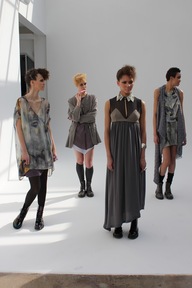On byproducts - Anouchka Grose in Harper’s:
‘In psychoanalysis, if you speak to people over time it often becomes apparent that their relationship with the things they wear isn’t easy. Perhaps they feel that everyone else is better dressed than them, or they overspend, or they get into relentless cycles of ordering and returning, or they wear their mother’s designer hand-me-downs and feel annoyed and resentful.
In my analytic practice I once worked with a woman who went on a massive spending spree the week before she made a serious suicide attempt. After coming out of the hospital, she returned some of the clothes, but kept a cashmere coat as a kind of memento. She saw the two activities—shopping and taking an overdose—as being closely linked, as if the shopping had been a milder form of self-harm; an attempt to stave off the later, more damaging one.
To understand this, we can turn to Jacques Lacan’s seminal 1949 essay on the “mirror stage.” At the risk of oversimplifying, a human infant is uncomfortable in its own skin, which is why it cries so much. A baby can’t control anything much, certainly not its own body, and just has to scream and hope for the best. Then, at around six months—once their nascent cognitive faculties are sufficiently up and running—they are suddenly able to grasp the notion that the thing they see reflected back in a mirror is them.’
(…)
‘That’s the tragedy of the human condition, according to Lacan: constant alienation. The mirror image helps us to understand something about what we are, but it also condemns us to constantly fall short of our own expectations.
Fashion both exploits and alleviates this situation, because of its dual structure of enjoyment and suffering, pleasure and pain, irritation and relief. On the one hand, you have the side of fashion that actually helps us to enjoy inhabiting our bodies. Clothes can conceal the bits you feel ashamed of and accentuate the bits you’re proud of. They give us different shapes and colors to experiment with, offering a general defamiliarizing effect which can be an incredible relief, even if it’s only temporary.
But on the other hand, there’s this system called fashion that isn’t really about clothes in any practical sense, but about the endless replacement of clothes by other clothes.’
(…)
‘Any fashion item, from the moment it appears, openly betrays a trace of its future unfashionableness. The freshest, most desirable garment has its fate written all over it. The “failed” clothes are then cast out and new ones brought in to fulfill the old ones’ promises. But perhaps the potentially endless disappointment of this scheme is redeemed by the secret pleasure with which the disastrous ex-fashion is discarded. What if waste was a delicious revenge against clothing for its failure to make us feel good about ourselves? Whereas the fashion system may at first seem to be attempting to control loss by always having something new with which to replace the discarded object, loss may in fact be controlling the system. Instead of being a byproduct, the debris of fashion may in fact be its primary driving force.’
Read the complete article here.
The debris is the raison d’être of fashion, because every garment that claims to be fashionable reveals already the future unfashionableness of the garment. If you wait long enough this process might be reversed.
It’s all about replacement, fashion. The replacement theory, popular among the extreme-right everywhere, is grounded in the fear that people are just garments.
You are future unfashionableness. You are nothing more than unfashionableness. That’s the alienation.
Democracy can only be saved when a rather large majority remains convinced of their own fashionableness.
We should defend democracy, but we should also admit that actually existing democracy has many things in common with fashion.
